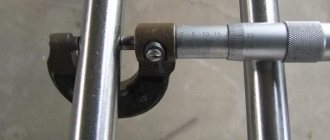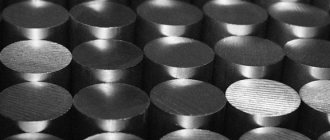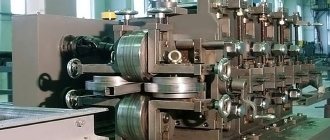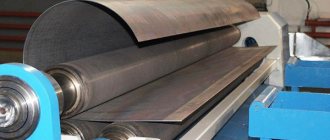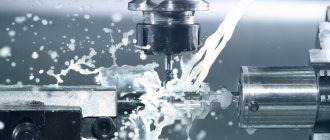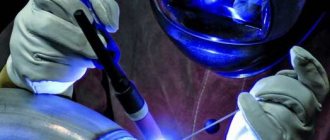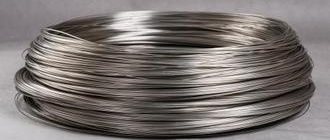There are different types of steels that differ in their composition, properties and applications. For the manufacture of supporting handrails and railings, both chrome and stainless steel can be used. In appearance, products made of chrome and stainless steel are very similar - they look aesthetically pleasing and have a special shine, thanks to the chromium present in their composition.
Differences between stainless and chrome steel
Products and structures made of mirror stainless steel
The attractive appearance and excellent strength and performance parameters of stainless steel products allow it to be widely used in the manufacture of various structural elements that carry not only operational, but also aesthetic loads. Railings, handrails, fences must be not only durable, but also beautiful, organically combined with the overall style of the interior or exterior of the architectural object. It is also important that parts made of mirror stainless steel are perfectly combined with most materials and coatings used in construction and finishing.
The high resistance of stainless steel to corrosion allows it to be widely used outdoors in the form of railings, handrails, fences, as well as in facilities with high humidity (stairs to swimming pools) and those where special importance is placed on sanitary and hygienic conditions (kitchen shops, facilities catering, medical institutions).
Difference between mirror stainless steel and chrome plating
Many people mistake regular chrome plated carbon steel for mirror stainless steel. In fact, chrome-plated (with an outer protective chrome coating) carbon steel is often used as a low-cost alternative to stainless steel. However, all its advantages end at a relatively low price.
To ensure that chrome steel is price competitive, the protective coating is applied in a very thin layer. If we take into account that chrome is inferior in hardness and strength to stainless steel, then you can get a situation where the coating wears off quite quickly, after which the base made of ordinary steel begins to quickly rust.
An example would be a regular stair railing somewhere in a high-traffic public area. Their surface is almost continuously exposed to the mechanical action of hundreds and thousands of human hands. In addition, there are always asocial individuals who, using hard and sharp objects, deliberately scratch some inscriptions and drawings on the railings. If the handrails are made of stainless steel, then such scratches will be barely noticeable (and it is quite difficult to scratch stainless steel), and the fence itself will last indefinitely without any repairs.
But if, out of a desire to save money, the object is equipped with chromed steel railings, then every scratch applied to them will almost immediately become clearly visible due to the rust that forms under it. Moreover, if quite a lot of people walk along the stairs with such handrails every day, then even without any scratches the chrome coating will wear off in just a few years from the continuous impact of hundreds and thousands of human palms. After this, the railings will begin to rust intensively, and then lose their strength. As a result, after just a few years of operation they will require either serious and expensive repairs or complete replacement.
That is why experts do not recommend using chrome railings and handrails in the fresh air, as well as in crowded places, albeit sheltered from weather factors (for example, in the subway or in shopping centers).
To summarize, let’s briefly clarify the differences between stainless and chrome steel.
- Chrome steel is regular carbon steel with a thin outer layer of chrome plating.
- Stainless steel is a special class of alloy steel that contains at least 13% chromium.
Physical and mechanical:
- By appearance, it is quite difficult to distinguish new railings, handrails or fences made of chrome-plated steel from those made of mirror stainless steel. But this only applies to truly new products. If an element made of chromed steel is used for a long enough time, then the external differences between it and a similar stainless steel product (with the same service life) will become very noticeable and not at all in favor of the chrome-plated one.
- Stainless steel has increased strength and hardness. It is very difficult to damage its surface (chip or scratch) without serious effort and a special tool. But even if there are scratches on its surface, they are barely noticeable, since the inner layers of the material do not differ in color from its surface. Such minor surface damage does not affect the strength and corrosion resistance.
- It is not difficult to damage the surface of chrome steel; this can be done with any sharp object, even by accident. Scratches and chips on the surface become clearly visible almost immediately. In addition, their presence has a detrimental effect on the mechanical characteristics of railings, handrails and fences due to the onset and continuous development of corrosion processes. The thin chrome coating gradually wears away under the influence of weather and mechanical factors.
Conclusion. While stainless steel products and structures are practically eternal, their chrome-plated counterparts have a limited service life.
Its use in construction
In construction and renovation work, metal is used exactly in accordance with its normal use, that is, either in the form of an alloy, mainly stainless steel, or in the form of a temple covering. And everyone is familiar with this type of decorating metal objects.
We will talk about metal structures as a way to use chromium further.
Metal constructions
In construction, ordinary black steel is used very rarely, as it does not have sufficient durability.
As a rule, these are products that are not designed for long-term use - containers, for example. If fasteners or a frame of “long-term use” are required, then the material is galvanized steel. However, the latter does not provide 100% corrosion resistance. Firstly, when galvanizing, some errors are always possible. Secondly, if the zinc layer is damaged or worn out, the steel becomes defenseless against moisture and air.
Stainless steel with an admixture of chromium and nickel does not have these disadvantages. Coupled with the high resistance to temperature, which is provided by the same chromium and nickel, stainless steel demonstrates such durability, which often far exceeds the durability of all other materials - brick, roofing, sheathing.
Does stainless steel rust? Causes of the problem and ways to combat it
The appearance of defects on the surface of metals is puzzling and suggests low quality steel. Even more questions arise if brown rust spots appear on high-alloy steel. It is important to understand in time what caused such a defect and what to do next to stop this process.
Stainless steel has durable properties thanks to chromium as the leading alloying element. Even a small amount of chromium in the alloy helps form a thin film of chromium oxide, which prevents corrosion due to exposure to aggressive reagents, water, and alkalis.
Special products for cleaning chrome parts
When choosing a chemical intended for rust removal, you must carefully read the accompanying information .
The liquid or paste must be approved for use on chrome plating.
It also matters:
- expiration date of the product,
- its cost,
- Ease of use,
- harmless to human health.
The drug was developed by an American company of the same name. WD-40 is an aerosol used in everyday life and in auto repair shops.
The product is versatile and can be used to remove marks:
The product includes:
- White Spirit,
- carbon dioxide,
- mineral oil,
- inert additives.
To clean rust, the product is sprayed onto the surface to be cleaned, left for a short time and wiped with a napkin. A 200 ml bottle can be bought for 200-300 rubles.
Doctor Wax
The product from a well-known American brand is available in the form of a polishing paste . It is suitable for cleaning not only chrome surfaces, but also coatings made of:
Doctor Wax is applied to surfaces with rust. After some time, when the paste dries and turns into a matte coating, the coating is polished with a soft cloth. The cost of a can weighing 0.18 kg is on average 350 rubles. A 300 ml bottle is estimated at 380-400 rubles.
Metal Polish
The polish was developed by the German company Autosol. The product has a creamy consistency. Metal Polish is used for cleaning and polishing:
- dishes,
- plumbers,
- car body,
- industrial equipment.
May be used for:
The average price for a tube of paste with a volume of 0.75 ml is 450 rubles, a large jar with a volume of 0.75 liters costs from 2,700 rubles (all prices are here).
In order to efficiently remove rust stains from chrome plating, you must follow the instructions and follow the safety rules noted.
Conditions in which rust occurs
There is no need for special conditions under which rust inclusions appear on the surface of stainless metal. A slight decrease in the concentration of chromium in the alloy is sufficient for the surface to become susceptible to destructive external influences. Another condition under which the outer layer begins to deteriorate is contact of iron with a stainless surface.
The condition under which a violation of the chromium-protected metal layer occurs is incorrect welding technology. Iron particles fall on the surface of the stainless steel. If you then poorly clean the surface, then the smallest particles lead to the appearance of corrosion inclusions on the stainless steel. A poorly cleaned weld seam, or rather the area around the welding site is covered not only with iron residues, but also with slag, welding spatter, and flux. The inclusions will not always develop into full-fledged corrosion with through holes. Even the most perfect seam will look untidy if the surface around it is not cleaned and defects are not removed. In the catalog on our website you can buy a stainless steel seamless pipe 12x18n10t - a way to avoid the risks that arise during welding.
Useful tips on how to remove rust from a chrome surface
The appearance of rust on a chrome surface is an unpleasant, but solvable problem.
Plumbing fixtures, wheel rims and other chrome-plated products are cleaned with home remedies or special pastes designed to combat metal oxides.
To achieve the desired effect and not damage the coating, you must follow the instructions and remember the important nuances of cleaning.
In this article we will tell you how you can remove rust from chrome surfaces without damaging them.
Types of corrosion
Effective additives that provide high-alloy alloys with anti-corrosion properties do not always solve problems with the appearance of defects. There are six main types of rust that affect stainless steel. It’s worth talking about them in more detail:
1. Crevice corrosion
. When designing products and massive metal structures, gaps arise or fastening points are not sealed well enough. Gradually, water or acidic reagents deactivate the oxide layer. If you do not create conditions in time in which the reaction stops, not only the attachment point, but also the fasteners will rust.
2. Pitting corrosion
. Occurs when the technology for working with stainless steel is violated. Aggressive external environment, small particles of metal dissolve the protective oxide layer, penetrating deep into the alloy, forming pitting.
3. Galvanic corrosion
. The condition for its manifestation is a conductive medium. Stainless steel comes into contact with aggressive reagents and the destructive properties of the protective layer of chromium are fully manifested.
4. Intergranular corrosion
. There are conditions under which steel crystals fall out when welding stainless steel. Pinpoint gaps are formed, in which rust subsequently develops.
5. General corrosion
. It occurs when iodine, chlorine, and fluorine get on the surface, destroying the molecular structure of the chromium-containing protective layer.
6. Erosive corrosion
. Occurs under conditions of constant mechanical impact on the surface of stainless steel.
How to deal with stainless steel corrosion?
a) In metallurgical plants where workpieces are stored, storage conditions must be observed and situations where particles of unalloyed metal fall on the stainless steel must be prevented.
What can't be used and why?
The shiny chrome finish is sensitive to many aggressive and rough products. Therefore, when choosing a suitable method, it is worth keeping in mind unwanted cleansers.
- Steel wool . It spoils the gloss of the chrome finish and makes it dull.
- Metal scourers . Such sponges can remove rust, but leave marks on the coating.
- Strong acids . Sulfuric, hydrochloric and other acids destroy the protective coating.
Why does stainless steel rust?
Rust on stainless steel raises many questions. Is this steel really stainless? If it is stainless steel, then why did it rust? Where does rust come from? Will the stainless steel continue to rust, and will this lead to the formation of through corrosion?
Stainless steels are resistant to corrosion because their composition has a high percentage of chromium. When this element is present in steel in sufficient quantities and is subjected to oxidative attack by acids, alkalis, water, air and other media, it forms a very thin (130 angstrom) impenetrable layer of CrO oxide, which stops further corrosion.
In this regard, stainless steels are very similar to aluminum, which also forms a protective oxide layer. The CrO layer differs from aluminum oxide in that it is never so thick that it is even visible to the naked eye. Chromium must be distributed evenly throughout the steel structure in order for it to become “stainless steel.”
What causes rust to form on stainless steel surfaces?
Rust forms on stainless steel surfaces when there is not enough chromium alloy to create and maintain the required oxide layer.
The simplest condition under which rust can occur on stainless steel is when regular carbon or low-alloy steel comes into contact with stainless steel.
Another type of rust formation on stainless steel occurs during welding, such as when welding using cored wire. An uncleaned stainless metal surface can leave a thin layer of free iron that rusts easily if the metal surface is not abrasively or chemically cleaned after welding.
The technology for manufacturing and operating stainless steel should ensure that it does not come into contact with ordinary steel, for example, in the manufacture of tables, lifting equipment, warehouse racks and other metal structures. Iron dust generated during grinding, cutting, and blasting should be kept as far as possible from areas where stainless steel is used.
Cleaning and abrasive tools such as grinding wheels and wire brushes previously used on carbon or low alloy steel should not subsequently be used on stainless steel.
For stainless steel, only stainless steel wire brushes should be used. The constant use of metal brushes, even stainless steel, is not recommended, as they leave mechanical damage on the surface, which contributes to the formation of corrosion. Wire brushing can be used to remove welding slag.
The presence of free iron on the surface of stainless steel can be easily determined by spraying the steel with water and keeping it wet for several hours.
Areas containing free iron will rust and become discolored.
A much faster way to detect free iron is the ferroxyl test. The composition for surface treatment includes:
1) distilled water – 1 liter,
2) nitric acid – 30 milliliters,
3) potassium ferrocyanide – 30 grams.
Metal processing must be carried out in protective clothing, since the composition contains acid and cyanide. The surface in contaminated areas will turn blue within a few minutes. Then the composition must be washed off with water and neutralized with a soda solution. However, this method is not suitable for testing food contact surfaces.
Very often the corrosion process develops along the edges of the weld. The color of the oxides can range from straw to dark brown, eventually turning to the red color of rust.
Under normal atmospheric conditions, welding-related corrosion does not develop, but simply looks unsightly. Welds should be cleaned within one or two days after welding, rough or rough surfaces should be sanded, scratches, slag, flux and spatter removed.
There are many special cleaning agents for stainless steels available on the market. These detergents are made from nitric or hydrochloric acids; they usually remove a small layer of material (about 0.025 mm). After exposure to the surface, they must be thoroughly washed off and neutralized with water and soda.
Passivation of stainless steel products in nitric acid helps accelerate the formation of a chromium oxide film, which prevents corrosion of the metal.
Recommendations
In order to be 100% satisfied with the result of the work, you must follow the instructions included with each product and remember the additional recommendations:
Before applying a reagent or using mechanical cleaning from a chrome-plated product, it is recommended to wash off the dirt to facilitate contact with rust.- The soak time in the cleanser should be adjusted depending on the extent of the damage. Areas with a thicker layer of rust require a longer treatment period.
- After cleaning, the product must be wiped with a dry cloth. It is not advisable to leave the coating to dry naturally, as unsightly water stains will remain on the glossy surface.
- For additional polishing of chrome, it is useful to use oily substances. Vegetable oils and wax polishes are suitable. They are dripped onto a microfiber cloth and rubbed until the surface shines.
Galvanized or stainless steel: the difference in price pays off during operation
You can place an order by phone
Our specialists will be happy to help you
Galvanized and stainless steel have common properties of corrosion resistance and resistance to environmental influences, which makes the use of these types of metal popular in construction and industrial purposes.
Chrome steels
Chromium steels are not deficient in terms of alloying materials and are widely used for the manufacture of various types of equipment operating at high pressure and temperature under conditions of exposure to aggressive environments.
Alloying with chromium not only ensures the corrosion resistance of steels in oxidizing environments, but also determines their structure, mechanical properties, heat resistance, and technological properties. Forming a continuous series of solid solutions with iron at concentrations up to 12%, chromium then contributes to the closure of the γ-region, which is the main reason for the formation of different structures and the diversity of their properties in chromium steels.
Distinctive features of galvanization and stainless steel
Stainless steel and galvanization differ in their production method, composition, durability, and these characteristics affect the difference in price, reaching 25–40%. This variation in cost is explained by the improved characteristics of corrosion-resistant stainless steel compared to galvanized metal.
Cink Steel
Galvanized steel is produced by coating a sheet of carbon steel with a thin layer of zinc, which over time (up to two years) forms a durable patina on the surface that is resistant to atmospheric moisture and oxygen.
Galvanization must “stand” so that the products of natural oxidation disappear and the zinc patina layer gains strength. Zinc-coated steel sheets differ in appearance from stainless steel - zinc crystallization patterns reminiscent of “white rust” are visible on their surface.
Galvanized steel has the following performance characteristics:
- service life - up to 25 years with a zinc coating layer 60 microns thick;
- high ability to withstand mechanical loads by rolling, forging, bending, drawing, stamping;
- resistance to pressure loads;
- resistance to temperature changes;
- low electrical conductivity.
Galvanization is not resistant to acids: with the help of hydrochloric acid it can be distinguished from stainless steel. The zinc coating actively reacts chemically with acid, while stainless metal alloyed with chromium does not react to an acidic environment.
Stainless steel
The high-tech process for the production of stainless austenitic steel is based on alloying the alloy with nickel, manganese, and chromium additives, which create corrosion-resistant films on the surface. The material that comes out of production is ready for use and further processing and has the property of self-healing chromium oxide film.
Stainless steel has better properties compared to galvanized metal:
- service life – up to 50 years;
- plasticity and ability to deform;
- resistance to impact loads;
- high corrosion resistance to moderately organic and acidic environments;
- ease of processing;
- resistance to high and low temperatures;
- environmental Safety.
Stainless steel does not form harmful compounds upon contact with food and thermal exposure, which distinguishes it from galvanized metal. Galvanizing can be oxidized by many foods and release poison.
offers high-quality stainless, corrosion-resistant austenitic steel at a competitive price, which is due to the absence of intermediaries between the production company and consumers of stainless steel products. The cost of stainless steel products pays off with twice the service life compared to galvanized steel.
Folk and improvised means
Before you clean chrome parts from rust at home, it is worth evaluating several of the most effective means.
Baking soda with water
They should be mixed so that a paste is formed. This mixture should be applied to the damaged surface for several minutes. Subsequently, the soda should be removed using a dry and soft cloth.
Soda for rust on metal. It must be used by mixing with water. No vinegar!
Grinded chalk with toothpaste
This special folk method implies the need to mix these substances in approximately equal proportions until a homogeneous paste is formed. The resulting composition must be applied to a flannel rag and thoroughly wipe the damaged surface of the chrome areas with it.
A product that removes minor scratches on a car
After cleaning, remove any remaining home remedy using a dry and soft cloth.
Coca-Cola with foil
Initially, chrome parts should be cleaned of dirt and wiped. After this, they should be washed with warm water. Next, use Coca-Cola to moisten the foil. The latter must be used to rub the surface of chrome parts until corrosion stains are completely removed. Finally, polish with felt or a soft cloth.
Some craftsmen cope with Coca-Cola
Buying quality stainless steel railings
Railings with 3 stainless steel crossbars are the most popular. Why? Because the optimal combination of price/quality. In shops and shopping centers, handrails are made of stainless steel, and in private homes - made of wood or plastic. AISI 201 steel grade is used, which reduces the cost of the railings.
Stainless steel grades and application on objects
Several grades of stainless steel are used: AISI 201, AISI 304, AISI 316.
- AISI 201 stainless steel is used in enclosed spaces where there is no exposure to a humid environment. It is used in the manufacture of steel railings for stairs in residential buildings, shopping centers, and shops. No metal corrosion occurs indoors.
- AISI 304 stainless steel is used outdoors. It is more resistant to external influences, including moisture. However, railings made of such steel are afraid of the anti-icing agents that are sprinkled on the streets in winter. Used in the manufacture of ramp fencing.
- AISI 316 stainless steel is used in railings and fences in very wet environments, such as swimming pools. 316 stainless steel railings are very resistant to salts in the water. Such railings and fences do not rust, but their cost is higher.
Why stainless steel rusts: Examples from life
- The client orders outdoor fencing, and the contractor wants to save money on the client and specifically uses steel grade 201, instead of 304. As a result, rust appears after a few weeks.
- The client orders outdoor fencing, the contractor conscientiously uses 304 steel, but as a result of the use of anti-icing agents, the steel corrodes.
- The client orders railings for the pool, the contractor uses 304 steel. After a while, the railings begin to become covered with rust.
